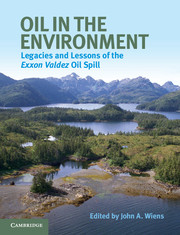Book contents
- Frontmatter
- Contents
- List of contributors
- Use of acronyms
- Acknowledgments
- A bibliographic note
- Prologue
- Part I Introduction and background
- Part II Oil in the environment
- 3 Oil in the water column
- 4 Surveying oil on the shoreline
- 5 Ancient sites and emergency response: cultural resource protection
- 6 Fate of oil on shorelines
- 7 Understanding subsurface contamination using conceptual and mathematical models
- 8 Removal of oil from shorelines: biodegradation and bioremediation
- Part III Biological effects
- Part IV Assessing oil spill effects and ecological recovery
- Part V Conclusions
- Index
- References
3 - Oil in the water column
Published online by Cambridge University Press: 05 July 2013
- Frontmatter
- Contents
- List of contributors
- Use of acronyms
- Acknowledgments
- A bibliographic note
- Prologue
- Part I Introduction and background
- Part II Oil in the environment
- 3 Oil in the water column
- 4 Surveying oil on the shoreline
- 5 Ancient sites and emergency response: cultural resource protection
- 6 Fate of oil on shorelines
- 7 Understanding subsurface contamination using conceptual and mathematical models
- 8 Removal of oil from shorelines: biodegradation and bioremediation
- Part III Biological effects
- Part IV Assessing oil spill effects and ecological recovery
- Part V Conclusions
- Index
- References
Summary
Introduction
When crude oil or petroleum products are released during a marine oil spill, organisms living in the water or feeding at the surface are the first to be affected. Oil on water or mixed into the water column may injure aquatic species of all types. Understanding the potential for injury to organisms from exposure to oil requires fully studying physical and chemical effects and quickly communicating the results. The risks to the public from the consumption of fish or other species normally harvested from the water can also be serious. A comprehensive water-assessment program provides quantitative data to address multiple concerns.
The Exxon Valdez oil spill was, until recently, the most comprehensively sampled oil spill in history and remains the most exhaustively studied oil spill. In fact, the thoroughness of the data – and the disappearance of most oil slicks and sheens by the end of the summer of 1989 – enabled all commercial fisheries to be reopened in 1990, much earlier than had been anticipated. Techniques and protocols established during the Exxon Valdez spill have been used in subsequent spills, most notably in the 2010 Deepwater Horizon oil spill in the Gulf of Mexico.
- Type
- Chapter
- Information
- Oil in the EnvironmentLegacies and Lessons of the Exxon Valdez Oil Spill, pp. 57 - 77Publisher: Cambridge University PressPrint publication year: 2013



